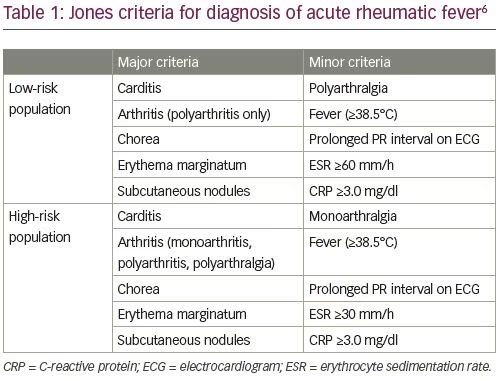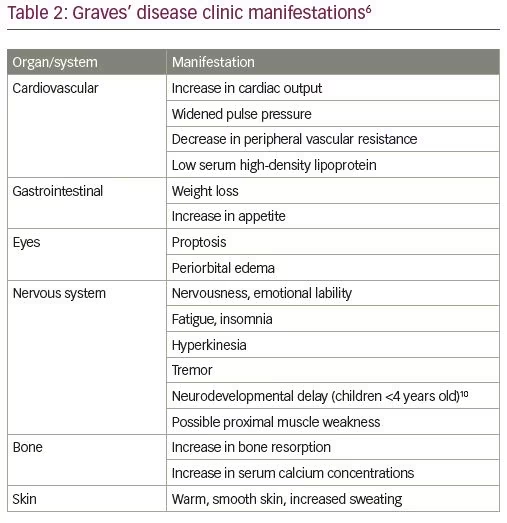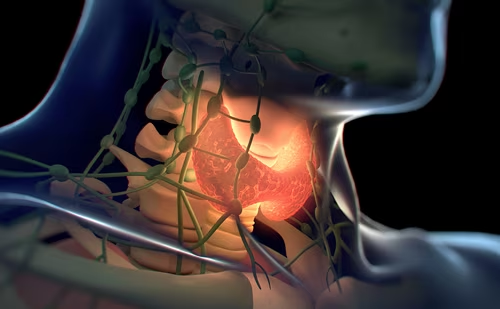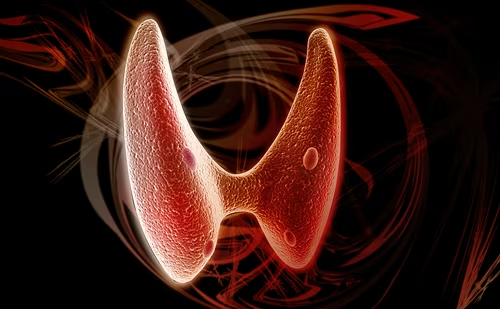Hyperthyroidism is associated with neurological symptoms, such as tremor and muscle weakness, but chorea is rare and occurs in less than 2% of patients.1 Chorea is rarely seen at presentation in Graves’ disease, and more commonly occurs with streptococcal infection. Acute rheumatic fever is a well-known sequela of streptococcal pharyngitis that is diagnosed based on the Jones criteria.2 Major criteria include carditis, arthritis, chorea, erythema marginatum, and subcutaneous nodules.2 Rapid recognition and treatment of streptococcal pharyngitis with penicillin is important to prevent progression to acute rheumatic fever. While hyperthyroidism can be associated with neurological symptoms, this patient’s acute onset of choreoathetoid movements and neurological symptoms following her episodes of strep pharyngitis with mitral valve involvement led to the diagnosis of acute rheumatic fever. This case shows that clinical signs and symptoms can indicate a more serious or complex condition.
Case
A 13-year-old girl with newly diagnosed hyperthyroidism secondary to Graves’ disease presented with worsening left-sided upper extremity weakness and gait unsteadiness for 1 month. In addition, she presented with symptoms typical for hyperthyroidism, including palpitations, headache, weight loss, and heat intolerance. The patient had neurologic symptoms, such as tremors in her left hand and weakness while playing the flute for about a month prior to the diagnosis of hyperthyroidism. Additional neurologic symptoms included gait alterations with left foot drop. She tripped once due to weakness but was otherwise able to walk. Her parents reported that she had slurred speech since the previous day. She had no confusion or mental status changes, no dysphagia, and no facial droop. She denied sensory symptoms, such as numbness or tingling. She had a history of strep throat 3 weeks prior, for which she was not treated, and a second episode of strep within the past week that was treated with oral amoxicillin-clavulanic acid. She also had a history of depression, anxiety, and self-harm behaviors, for which she had been followed by a mental health professional for the past year.
Laboratory evaluation was consistent with autoimmune hyperthyroidism. Specifically, thyroid-stimulating hormone (TSH) was <0.02 MCIU/ml (0.4–4.0 MCIU/ml), free thyroxine 4.2 ng/dl (0.8–2.0 ng/dl), triiodothyronine 689 ng/dl (80–180 ng/dl), thyroid peroxide antibody 974 IU/ml (<35 IU/ml), thyroid globulin antibody 602 IU/ml (<20 IU/ml), and thyroid-stimulating immunoglobulin (TSI) 2.2 (positive is ≥1.3 TSI index). The TSI was sent to the Mayo Clinic for measurement and was analyzed using a recombinant bioassay.3 Complete blood cell count, blood metabolic panel (sodium, potassium, total calcium, glucose, blood urea nitrogen, creatinine, carbon dioxide, anion gap), and hepatic profile were within normal limits. She was started on oral methimazole and propranolol for the management of hyperthyroidism. Methimazole inhibits thyroid peroxidase and interferes with iodination of thyroid resides in thyroglobulin, which prevents the synthesis of thyroxine and triiodothyronine. Propranolol treats hyperadrenergic symptoms of hyperthyroidism, such as tremor, sweating, and anxiety by decreasing peripheral conversion of T4 to T3.
Due to unusual presentation and slurred speech, the patient was admitted for further evaluation. Neurology was consulted and she was diagnosed with Sydenham chorea. The recent diagnosis of strep pharyngitis, Sydenham chorea, and mitral valve involvement with elevated anti-streptolysin O and anti-DNAse B titers met criteria for acute rheumatic fever. An echocardiogram showed the mitral valve annulus was dilated with thickened anterior leaflet with prolapse and moderate mitral regurgitation. She was treated with intravenous (IV) steroids (methylprednisolone 1,000 mg) for 5 days for her chorea. There was consideration for other therapies, including IV immunoglobulin (IVIG), plasma exchange, and oxcarbazepine if there was no improvement with steroids. The patient demonstrated significant improvement with steroids; therefore, the additional therapeutic options mentioned above were not required. She was treated with penicillin G 1.2 million U intramuscular every 4 weeks, and is continuing to take this monthly. Per current guidelines, prophylaxis for rheumatic fever with rheumatic heart disease is indicated for at least 10 years after the last episode of acute rheumatic fever or until age 21, whichever is longer. For persistent valvular disease (clinical or echocardiogram evidence), prophylaxis is continued for 10 years after the last episode or until age 40, whichever is longer.4
The patient completed 5 days of IV steroids, and showed an improvement in her weakness and chorea and was discharged home on steroid taper. She was advised by her cardiologist and infectious disease physician to receive 10 years of prophylaxis for recurrent acute rheumatic fever due to her presentation with subclinical carditis. The cardiologist advised follow-up 2 weeks after discharge and recommended resting at home. At 2 weeks’ follow-up, her echocardiogram was unchanged and she continued to have no symptoms of mitral regurgitation. She was then cleared to return to school.
At 1-month post discharge, she had some evidence of milkmaid grip and choreic posturing on left arm tonic extension, which was much improved from the chorea that was present during her hospitalization. This was still present 4-months post-discharge. Twelve months post discharge, neurological examination demonstrated that choreic movement had completely resolved. An echocardiogram was repeated and was unchanged. She was instructed to follow up with a cardiologist annually, or sooner if she started developing symptoms of mitral regurgitation. Twenty-two months after diagnosis with rheumatic fever, her electrocardiogram is normal, and the echocardiogram continues to show a thickened anterior mitral valve. She has mild prolapse and mild-moderate mitral regurgitation.
The patient was started on methimazole (0.3 mg/kg/day) at diagnosis. Her dose of methimazole was gradually reduced over the course of the next year and by September, 2018 she was on a very low dose (0.04 mg/kg/day). Her dose was reduced based on gradual improvement and subsequent normalization of her thyroid function tests and clinical signs and symptoms. She continued on this low dose for 6 months, then she again became symptomatic, and laboratory investigation revealed totally suppressed TSH and elevated free T4 of 5.5 ng/dl (normal range 0.8–1.9 ng/dl). Her methimazole dose was increased to 0.3 mg/kg/day again. Of note, she had never been completely off methimazole.
Thyroid function tests normalized by July 2019 (4 months after methimazole was increased). Definitive treatment with either radioactive iodine ablation or thyroidectomy was discussed with the patient and her family. They chose total thyroidectomy as they felt it would be most appropriate for their personal living situation. The surgery was performed in September 2019 when she was biochemically and clinically euthyroid on 0.1 mg/kg/day of methimazole. Methimazole was discontinued postoperatively and she was started on thyroid hormone replacement. She is now clinically and biochemically euthyroid on 2 mcg/kg/day of levothyroxine. Unfortunately, she has developed mild permanent hypoparathyroidism which is treated with calcitriol 0.25 µg orally daily. To date, she has not been diagnosed with any other autoimmune conditions. She has been screened for celiac disease, diabetes, and adrenocortical insufficiency.
Discussion
Acute rheumatic fever is a well-known autoimmune response to streptococcal pharyngitis caused by a rheumatogenic strain of group A strep (GAS). Acute rheumatic fever damages heart valves and causes rheumatic heart disease. Rheumatic heart disease is a notable cause of morbidity and mortality in resource-poor settings around the world. The most common clinical presentations of acute rheumatic fever include acute fever, polyarthritis, carditis, and choreiform movements. The major complication of carditis in acute rheumatic fever is the development of chronic damage to the mitral/aortic valves resulting in mitral/aortic regurgitation or stenosis.2
Sydenham chorea is a neurological manifestation of acute rheumatic fever that usually resolves spontaneously, although some patients benefit from a course with steroids. Diagnosis is made clinically with supporting evidence of GAS antibodies. Unilateral chorea is seen sporadically, and the onset of chorea is 2–6 months after GAS infection.5
The Jones criteria have been accepted for several years as a guideline for the diagnosis of acute rheumatic fever (Table 1).6 The guideline was revised by the American Heart Association in 2015 and includes five major and four minor criteria for the diagnosis of acute rheumatic fever. Diagnosis is made when a patient fulfills two major manifestations or one major manifestation and at least two minor manifestations with evidence of recent GAS infection and elevated antistreptolysin O titer, anti-DNAse antibodies, rapid strep test, or throat culture.2

The main reason for treating streptococcal pharyngitis is to prevent initial and recurrent attacks of acute rheumatic fever. Penicillin has been the main treatment for decades to alter the likelihood and severity of rheumatic heart disease after an episode of acute rheumatic fever. Penicillin or amoxicillin is thus the drug of choice for treatment of strep throat. Other antibiotics, such as cephalosporin, are recommended for patients allergic to penicillin.2 To reliably eradicate GAS from the upper respiratory tract and to prevent complications, oral penicillin or amoxicillin can be given for a duration of 10 days.2 Timely diagnosis and initiation of antibiotics shorten the clinical course and decrease the development of complications even when antibiotics are given up to 9 days of symptom onset.7
Autoimmune hyperthyroidism may present with several types of neurological findings. Clinical features are summarized in Table 2.6 Tremor is a common symptom of hyperthyroidism. A study at St. Lucas Andreas Hospital in Amsterdam found tremor in 76% of adult patients with newly diagnosed hyperthyroidism.6 In patients with hyperthyroidism, the tremor is usually high frequency and low amplitude, occurs with movement, and typically occurs in the upper extremities but can involve the face and head.8 Chorea is a rare symptom of hyperthyroidism and occurs in less than 2% of patients.9 The onset of chorea is typically gradual and involves the extremities but can also affect the trunk or facial muscles. A study published by the Institute of Neurology CCS in Yugoslavia describes a 50-year-old patient with four episodes of recurrent bilateral chorea-ballism and associated hyperthyroidism.9 Recurrence of bilateral chorea-ballism with increased serum levels of thyroid hormones and lack of relevant changes on brain computed tomography/magnetic resonance imaging suggested that chorea was due to thyrotoxicosis-induced biochemical changes.9 A study at the Hirosaki University School of Medicine in Japan describes a 23-year-old female with unilateral chorea of the left extremities associated with thyrotoxicosis. The authors concluded that increased sensitivity of dopamine receptors may be responsible for persistent choreic movements in thyrotoxicosis.5 Chorea may improve or resolve with correction of thyroid hormone levels that may occur rapidly or be delayed for several weeks or more after achieving a euthyroid state.8

Other neurological symptoms associated with hyperthyroidism include tremulousness, tremor in outstretched hands, tongue fasciculations, hyperactive deep tendon reflexes, and ataxia. Additional neurological symptoms seen in hyperthyroidism include speech and language delay, proximal muscle weakness, decreased muscle mass, and decreased efficiency of muscle contraction.10 A 19-year-old patient had a unique case of thyrotoxic myopathy presenting as a unilateral foot drop.11 Although rare, hyperthyroidism in children can be associated with personality changes, agitation, anxiety, depression, mania, and psychosis.12 Children can have mood swings and changes in behavior that may need further evaluation by a developmental specialist or child psychiatrist. Hyperthyroidism has been associated with autoimmune conditions including myasthenia gravis and Guillain–Barré syndrome. Children with myasthenia gravis typically present with generalized weakness, fatigability, and have extraocular muscle involvement.13 Guillain–Barré syndrome presents with flaccid symmetrical weakness of the limbs and areflexia that usually peaks within a month.14 The patient presented in this case study had neurological symptoms, such as unilateral upper extremity weakness, ataxia, tremor in her hands, foot drop, and slurred speech. The patient had choreoathetoid movements, which are characterized by rapid, irregular, aimless involuntary movements in the arms, legs, trunk, or facial muscles. While hyperthyroidism has associated neurological manifestations, her acute onset of choreoathetoid movements following her recent strep pharyngitis with mitral valve involvement led to the diagnosis of acute rheumatic fever.
This patient was recently diagnosed with Graves’ disease, and although rare, there have been cases of isolated chorea or choreoathetosis as the main manifestation of thyrotoxicosis that resolves once a euthyroid state is achieved.15 Graves’ disease is the most common cause of autoimmune hyperthyroidism in children and adolescents. The treatment of Graves’ disease is focused on restoring thyroid function and preventing the recurrence of hyperthyroidism. Treatment options for initial therapy of Grave’s disease include thioamides, such as methimazole.16 An average of 2 years’ remission has been achieved in 30% of children treated with antithyroid drugs.16 Additional therapy options include surgery or radioiodine therapy.16 The major problem with antithyroid drugs is the high relapse rate of 30%; however, more prolonged treatment with antithyroid drugs may increase the remission rate up to 50%.17
The patient reported in this case had an unusual constellation of symptoms not commonly seen at new onset of autoimmune hyperthyroidism. This case underscores the importance of prompt evaluation of clinical signs and symptoms that could indicate more serious, or complex, underlying pathology. Endocrinologists may see chorea at presentation in Graves’ disease, although it is rare. It is important to remember that if chorea is seen, it is vital to ask about recent streptococcal infection, as this would be a much more likely etiology.







